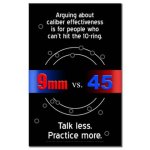So I have read many many threads about the caliber wars, bigger is a must etc, 9mm or 32acp way way to small etc. But if we look back to history these rounds were considered fine for self defense and other tasks, heck even the .22.
And in general I would consider people of the past far tougher than the average person today, and yet the smaller calibers suited them just fine.
So what has changed?
This leads me to my assertion/guess. Is it the quality of medical care that is available today?, this would make a fatal (or potential fatal)would of days gone by, far less critical by today's standards, and does this play into the mental state of a person that is shot?, knowing that they are still able to fight and still have a good change of being treated and surviving. Or is it something else?
Croc4
And in general I would consider people of the past far tougher than the average person today, and yet the smaller calibers suited them just fine.
So what has changed?
This leads me to my assertion/guess. Is it the quality of medical care that is available today?, this would make a fatal (or potential fatal)would of days gone by, far less critical by today's standards, and does this play into the mental state of a person that is shot?, knowing that they are still able to fight and still have a good change of being treated and surviving. Or is it something else?
Croc4

